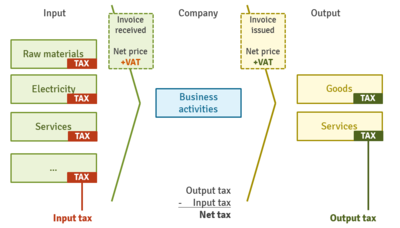Output tax: Difference between revisions
(Infobox update) |
|||
| Line 19: | Line 19: | ||
== Differences between output tax and input tax == | == Differences between output tax and input tax == | ||
[[File:input_output_tax.png|400px|right|thumb|Fig.1. Input and output tax in VAT system]] | |||
Output tax is taxable sales multiplied by the applicable VAT rate. Input tax is the VAT paid on taxable business purchases of inputs used in making taxable sales. A credit-invoice VAT thus relies on explicit charges for sales to calculated output tax. If the output tax exceeds the input tax at the end of any quarter, the excess shall be paid by the VAT-registered person representing his VAT payable to the BIR <ref>Crescenio P. Co Untian, Jr 2008, p.295</ref>. | Output tax is taxable sales multiplied by the applicable VAT rate. Input tax is the VAT paid on taxable business purchases of inputs used in making taxable sales. A credit-invoice VAT thus relies on explicit charges for sales to calculated output tax. If the output tax exceeds the input tax at the end of any quarter, the excess shall be paid by the VAT-registered person representing his VAT payable to the BIR <ref>Crescenio P. Co Untian, Jr 2008, p.295</ref>. | ||
Revision as of 09:39, 4 September 2020
| Output tax |
|---|
| See also |
Output tax is the value-added tax due on sale or lease of taxable goods or real estates or services by any person registered or required to register under the VAT system [1]. In the calculation, output tax is taxable sales multiplied by the tax rate, and input credits consist of both VAT on taxable imports listed on import documents and VAT on taxable local purchases listed on VAT invoices. Input credits for tax on imports and purchases are allowed only to the extent that the business inputs are used in making taxable sales. In several countries, such as sales within the EU, imports of goods are not taxed at the border but are reported and paid as output tax in the tax period in which the goods are imported, generally with an off-setting input credit [2].
Differences between output tax and input tax
Output tax is taxable sales multiplied by the applicable VAT rate. Input tax is the VAT paid on taxable business purchases of inputs used in making taxable sales. A credit-invoice VAT thus relies on explicit charges for sales to calculated output tax. If the output tax exceeds the input tax at the end of any quarter, the excess shall be paid by the VAT-registered person representing his VAT payable to the BIR [3].
Credit-invoice method
We have three alternative methods of calculation VAT: the credit method, the subtraction method, and the addition method. Under the credit method, the firm calculates the VAT to be remitted to the government by two-step process. First step, the firm multiplies its sales by the tax rate to calculate VAT collected on sales. Second step, the firm credits VAT paid on inputs against VAT collected on sales and remits this difference to the government. The firm calculates its VAT liability before setting its prices in orders to fully shift the VAT to the buyer. Under the credit-invoice method, a type of credit method, the firm is required to show VAT separately on all sales invoices and to calculate the VAT credit on inputs by adding all VAT shown on purchase invoices [4]. A lot of countries with VATs rely on the credit-invoice method, of calculating periodic tax liability. Registered business in most countries must report as output tax the tax on taxable sales taken from tax invoices. They claim as input credits the VAT charged on purchases used in making taxable sales. Businesses with turnover below the registration threshold are outside the VAT system. To ease the compliance burden on smaller businesses that are above the threshold but may not have sophisticated or computerized record keeping the VAT, by law, regulations, or administrative practice, may authorize simplified schemes to minimize VAT record keeping and reporting obligations [5].
Tax in mathematical terms
Taxes calculation [6]:
- Output tax - Input tax = VAT liability (if output tax is greater than input tax)
- Input tax - Output tax = Amount due from SARS (if input tax is greater than output tax)
Footnotes
References
- Bickley J. M., (2003). Value Added Tax: Concepts, Policy Issues, and OECD Experiences,"Nova Publishers".
- Crescenio P. Co Untian, Jr, (2010). Tax accounting Digest,"Rex Bookstore, Inc.".
- Schenk A., Oldman O., (2011). Value Added Tax: A Comparative Approach,"Cambridge University Press".
- Weil S. H., Noi S.A., (2001). Introductory Accounting Skills: For Financial and Management Accounting Students,"Juta and Company Ltd".
Author: Paulina Czarnota
